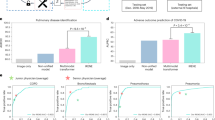Abstract
Electronic Health Record (EHR) contains a wealth of data from multiple modalities. Utilizing these data to comprehensively reflect changes in patients’ conditions and accurately predict their diseases is an important research issue in the medical field. However, most fusion approaches employed in existing multimodal learning studies are excessively simplistic and often neglect the hierarchical nature of intermodal interactions. In this paper, we propose a novel multi-grained cross-modal feature fusion network. In this model, we first use hierarchical encoders to learn multilevel representations of multimodal data and a specially designed attention mechanism to explore hierarchical relationships within a single modality. Afterward, we construct a fine-grained cross-modal clinical semantic relationship graph between code and sentence representations. Then we employ Graph Convolutional Networks (GCN) on this graph to achieve fine-grained feature fusion. Finally, we use attention mechanisms to fully learn the contextual interactions between visit-level multimodal representations, and realize coarse-grained feature fusion. We evaluate our model on two real-world clinical datasets, and the experimental results validate the effectiveness of our model.
Access this chapter
Tax calculation will be finalised at checkout
Purchases are for personal use only
Similar content being viewed by others
References
Jha, A.K., et al.: Use of electronic health records in us hospitals. New Engl. J. Med. 360(16), 1628–1638 (2009)
Scott Evans, R.: Electronic health records: then, now and in the future. Yearbook Med. Inform. 25(S01), S48–S61 (2016)
Shickel, B., Tighe, P.J., Bihorac, A., Rashidi, P.: Deep EHR: a survey of recent advances in deep learning techniques for electronic health record (EHR) analysis. IEEE J. Biomed. Health Inform. 22(5), 1589–1604 (2017)
Zhang, J., Kowsari, K., Harrison, J.H., Lobo, J.M., Barnes, L.E.: Patient2vec: a personalized interpretable deep representation of the longitudinal electronic health record. IEEE Access. 6, 65333–65346 (2018)
Luo, J., Ye, M., Xiao, C., Ma, F.: Hitanet: hierarchical time-aware attention networks for risk prediction on electronic health records. In: Proceedings of the 26th ACM SIGKDD International Conference on Knowledge Discovery & Data Mining, pp. 647–656 (2020)
Chang, L., Reddy, C.K., Ning, Y.: Self-supervised graph learning with hyperbolic embedding for temporal health event prediction. IEEE Trans. Cybern. 53, 2124–2136 (2021)
Bai, T., Chanda, A.K., Egleston, B.L., Vucetic, S.: EHR phenotyping via jointly embedding medical concepts and words into a unified vector space. BMC Med. Inform. Decis. Making 18, 15–25 (2018)
Liu, Z., Zhang, J., Hou, Y., Zhang, X., Li, G., Xiang, Y.: Machine learning for multimodal electronic health records-based research: challenges and perspectives. In: Tang, B., et al. Health Information Processing. CHIP 2022. Communications in Computer and Information Science, vol. 1772, pp. 135–155. Springer, Singapore (2023). https://doi.org/10.1007/978-981-19-9865-2_10
Liu, S., et al.: Multimodal data matters: language model pre-training over structured and unstructured electronic health records. IEEE J. Biomed. Health Inform. 27(1), 504–514 (2022)
Qiao, Z., Xian, W., Ge, S., Fan, W.: MNN: multimodal attentional neural networks for diagnosis prediction. Extraction 1(2019), A1 (2019)
Darabi, S., Kachuee, M., Fazeli, S., Sarrafzadeh, M.: Taper: time-aware patient EHR representation. IEEE J. Biomed. Health Inform. 24(11), 3268–3275 (2020)
Feng, Y., et al.: DCMN: double core memory network for patient outcome prediction with multimodal data. In: 2019 IEEE International Conference on Data Mining (ICDM), pp. 200–209. IEEE (2019)
Zhang, X., Li, S., Chen, Z., Yan, X., Petzold, L.R.: Improving medical predictions by irregular multimodal electronic health records modeling. In: International Conference on Machine Learning, pp. 41300–41313. PMLR (2023)
An, Y., Zhang, H., Sheng, Y., Wang, J., Chen, X.: Main: multimodal attention-based fusion networks for diagnosis prediction. In: 2021 IEEE International Conference on Bioinformatics and Biomedicine (BIBM), pp. 809–816. IEEE (2021)
Alsentzer, E., et al.: Publicly available clinical BERT embeddings. arXiv preprint arXiv:1904.03323 (2019)
Kazemi, S.M., et al.: Time2vec: learning a vector representation of time. arXiv preprint arXiv:1907.05321 (2019)
Tang, P., Zhang, X.: Features fusion framework for multimodal irregular time-series events. In: Khanna, S., Cao, J., Bai, Q., Xu, G. (eds.) PRICAI 2022: Trends in Artificial Intelligence. PRICAI 2022. LNCS, vol. 13629, pp. 366–379. Springer, Cham (2022). https://doi.org/10.1007/978-3-031-20862-1_27
Johnson, A.E.W., et al.: MIMIC-III, a freely accessible critical care database. Sci. Data 3(1), 1–9 (2016)
Johnson, A., Bulgarelli, L., Pollard, T., Horng, S., Celi, L.A., Mark, R.: MIMIC-IV. PhysioNet (2020). https://physionet.org/content/mimiciv/1.0/. Accessed 23 Aug 2021
Stallones, R.A.: The association between tobacco smoking and coronary heart disease. Int. J. Epidemiol. 44(3), 735–743 (2015)
Acknowledgement
This work was supported in part by the National Key Research and Development Program of China (2021YFF1201300), the National Natural Science Foundation of China (62372476), and the Natural Science Foundation of Hunan Province in China (2024JJ5446).
Author information
Authors and Affiliations
Corresponding author
Editor information
Editors and Affiliations
Rights and permissions
Copyright information
© 2024 The Author(s), under exclusive license to Springer Nature Singapore Pte Ltd.
About this paper
Cite this paper
An, Y., Zhao, Z., Chen, X. (2024). Multi-grained Cross-Modal Feature Fusion Network for Diagnosis Prediction. In: Peng, W., Cai, Z., Skums, P. (eds) Bioinformatics Research and Applications. ISBRA 2024. Lecture Notes in Computer Science(), vol 14955. Springer, Singapore. https://doi.org/10.1007/978-981-97-5131-0_19
Download citation
DOI: https://doi.org/10.1007/978-981-97-5131-0_19
Published:
Publisher Name: Springer, Singapore
Print ISBN: 978-981-97-5130-3
Online ISBN: 978-981-97-5131-0
eBook Packages: Computer ScienceComputer Science (R0)




